If you think all gloves are the same, think again. Today’s gloves are highly specialised tools - no longer just leather, sewn, or rigger styles. Thanks to modern materials, advanced coatings, and ergonomic designs, there’s a glove for almost every task, environment, and hazard. But what really makes one glove different from another? The answer lies in the coating.
We’ve been supplying gloves since 1996; over that time, we’ve learned that the coating on a glove often can be more important than the liner inside. Why?... It’s what touches the material you’re handling, and it determines grip, protection, dexterity, comfort, and even durability.
In this guide, we’ll break down everything you need to know about glove coatings, finishes, temperature considerations, and sustainability, all while referencing our Pawa® glove range.

Why Glove Coatings Matter
Think of a glove coating as your first line of interaction with the material you’re handling. It influences:
- Grip: Can you hold tools, components, or slippery materials securely?
- Protection: Are you safe from cuts, chemicals, oils, heat, or cold?
- Dexterity: Can you handle delicate or precise tasks?
- Comfort: Will your hands stay fatigue-free and dry over a long shift?
The wrong coating can cause slips, hand strain, or serious injury, while the right one makes your job easier, safer, and more productive.
Latex Coatings: Flexibility and Grip for Everyday Work
Latex is made from natural rubber and is one of the most versatile coatings. Its strength lies in elasticity and tactile sensitivity, making it perfect for tasks requiring dexterity and a strong grip.
When to use latex:
- Assembly work
- Handling dry materials like bricks, timber, or packaged goods
Everyday general-purpose work

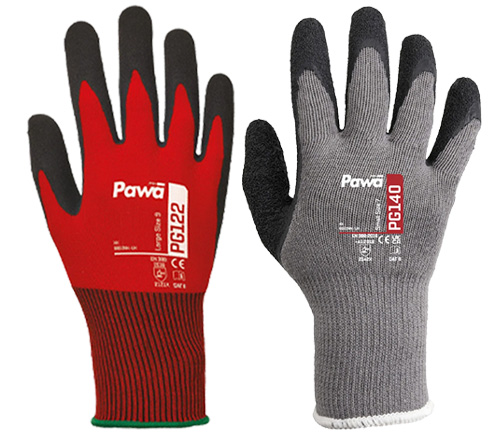
PAWA® Examples:
- PG122 Dexterous Gloves: Latex foam coating over the PureFit liner for maximum dexterity, anti-fatigue comfort, and superior grip. Ideal for high grip tasks or long shifts.
- PG140 Multi-Purpose Gloves: Crinkle latex coating provides powerful dry grip for construction or heavy-duty material handling. Ergonomic design reduces hand fatigue.
💡 Pro Tip: Smooth or foam latex is great for indoor precision work; crinkle latex excels at gripping dry, rough surfaces. Dual coatings, like in the PG201, combine waterproofing and grip for wet environments.
Nitrile Coatings: Oil, Chemicals, and Durability
Nitrile is a synthetic rubber and known for chemical, oil, and grease resistance. They are tougher than latex, resist punctures, and often outperform natural rubber in hazardous environments.
When to use nitrile:
- Automotive and mechanical work
- Chemical handling
- Oily tasks
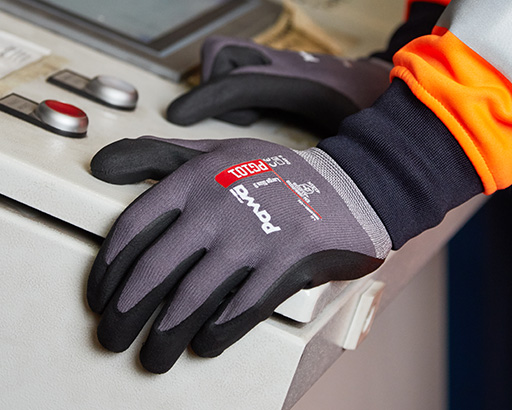
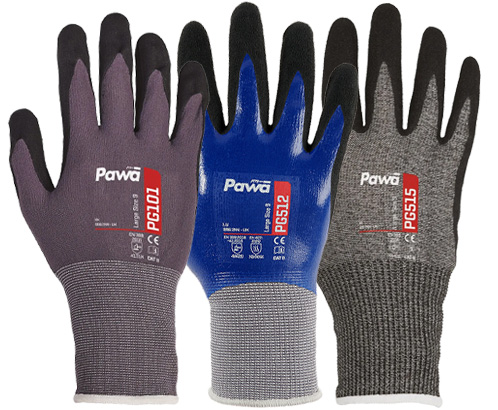
PAWA® Examples:
- PG101 Breathable Gloves: Micro-foam nitrile coating allows dexterity in oily conditions. Anti-fatigue technology keeps hands comfortable for long periods.
- PG512 Level D Cut Oil-Resistant Gloves: Dual-layer nitrile provides liquid resistance, and strong grip, ideal for oily materials.
- PG515 Anti-Cut Oil-Resistant Gloves: Sandy nitrile finish with second oil resistant palm coating for enhanced grip in greasy environments with Cut Level E protection.
💡 Pro Tip: Foam nitrile for comfort and dexterity, sandy or micro-surface for oil grip, dual-layer and oil protection combined.
Polyurethane (PU) Coatings: Precision and Touch Sensitivity
PU coatings are extremely thin and lightweight, offering excellent tactile sensitivity. They are perfect for tasks where precision is critical, like electronics assembly or modern manufacturing.
PAWA® Example:
- PG535 Ultrafine 18g Anti-Cut Gloves: Level D cut resistance, lightweight PU coating, reinforced thumb crotch, and touchscreen compatibility. Ideal for assembly lines and tasks requiring finger dexterity.

💡 Pro Tip: Use PU-coated gloves when precision outweighs chemical or oil resistance.
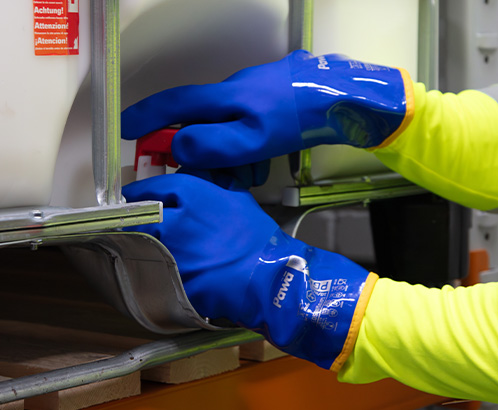
PVC Coatings: Wet, Oily, and Chemical Protection
PVC gloves are durable, waterproof, and often used in chemical handling or wet processing. Many are gauntlet-style to protect the forearm.
PAWA® Example:
- PG610 Type A Chemical Resistant Gloves: Triple PVC coating and sandy finish deliver oil resistance, grip, and comfort, with Silvadur™ treated liner for hygiene.
💡 Pro Tip: Gauntlet PVC gloves are perfect for wet, oily, or chemical-heavy environments.
Neoprene Coatings: Broad Chemical and Heat Resistance
Neoprene offers chemical resistance and moderate heat protection, often layered over nitrile for multi-hazard use.
PAWA® Example:
- PG600 Nitrile Type A Chemical Gloves: Neoprene over nitrile coating provides chemical resistance, oil repellency, and heat resistance up to 100°C. Forearm-length design for extra protection.
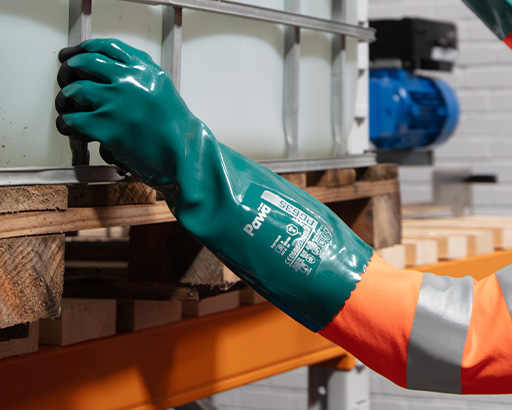
💡 Pro Tip: Use neoprene for chemical handling in wet or hazardous environments.
Finishes: How the Surface Changes Everything
The finish on a coating affects grip, comfort, and suitability:

Foam Coatings: Lightweight, breathable, channels moisture.
- Example: PG101 – dual-dipped latex foam for waterproofing and superior grip. – change point
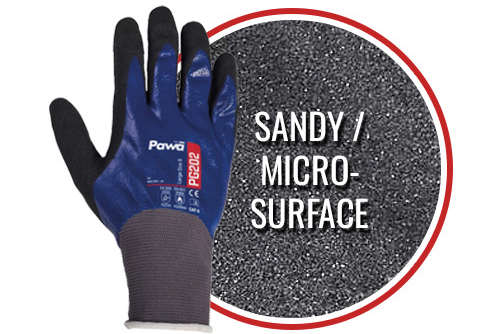
Sandy / Micro-Surface: Rough texture for oily or slippery conditions.
- Example: PG202, PG555 – automotive, maintenance, or oil handling.
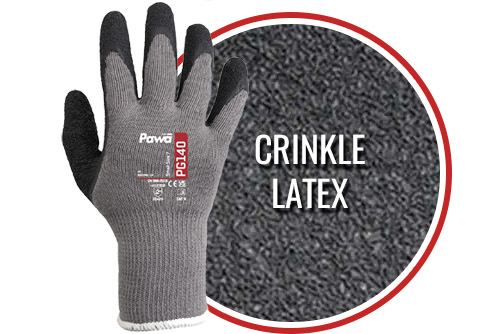
Crinkle Latex: Wrinkled texture improves dry grip and distributes stress.
- Example: PG140, PG520 – construction or heavy dry handling.
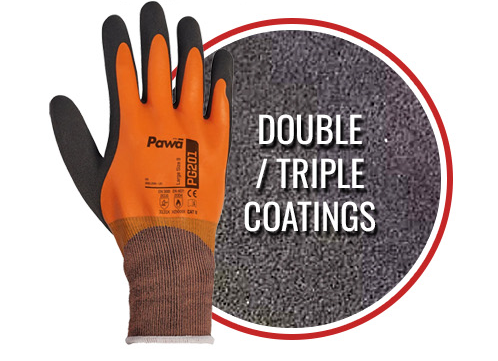
Double/Triple Coatings: Sequential layers for water repellency, grip, cut, or heat protection.
- Example: P201 – cut, water, and thermal protection in cold, wet, or slippery tasks.
💡 Pro Tip: Consider coating finish alongside material—it affects safety, comfort, and performance.

Temperature and Environmental Effects
Your gloves can perform differently depending on temperature and conditions:
- Cold: Latex may stiffen; PU may crack. Foam nitrile and neoprene excel. Thermal liners help.
- Heat: talk about dual coated gloves and how they provide more protection against heat,
- Wet Conditions: Foam and dual coatings channel moisture and maintain grip.
💡 Pro Tip: Always match the coating to the environment, not just the hazard.
Sustainability and Eco-Friendly Options
Performance doesn’t have to harm the environment. Our gloves even offer eco-conscious coatings:
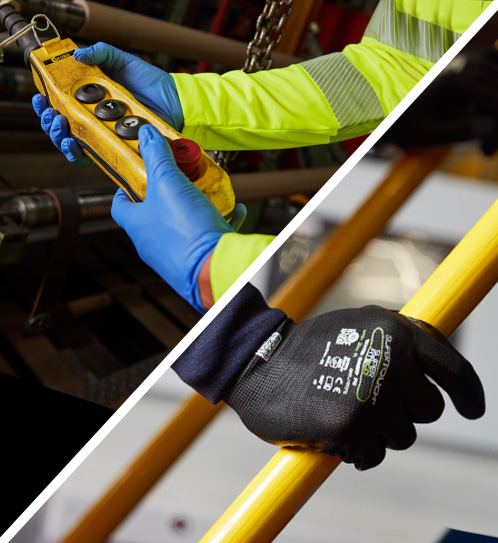
Water-Based PU & Nitrile:
- Superfit Eco Nitrile Micro Foam: 2.6 recycled PET bottles/pair, breathable, ergonomic, touchscreen compatible.
- Superfit Eco PU: DMF-free, water-based PU, 2.8 recycled PET bottles/pair.
Biodegradable Nitrile:
- 67.1% decomposition in 2 years, latex-free, textured fingertips, food-safe.
- GRS-Certified Coatings: Recycled polymers reduce carbon footprint without compromising protection or comfort.
💡 Pro Tip: For companies prioritising sustainability, these gloves reduce environmental impact while maintaining performance.

Choosing the Right Glove: A Practical Checklist
- Identify hazards: cuts, chemicals, oils, heat, cold, wet/dry surfaces.
- Select coating: latex (dry grip), nitrile (oil/chemicals), PU (precision), PVC/neoprene (wet/chemical), dual/triple layers (multi-hazard).
- Choose finish: foam (comfort), sandy (oil), crinkle (dry), multi-layer (combined protection).
- Consider environment: temperature and wet/oily surfaces.
- Ergonomics: anti-fatigue liners, seamless design, extended cuffs.
- Sustainability: water-based, biodegradable, or GRS-certified coatings.
With the right glove, you don’t compromise safety, comfort, or performance and with eco-friendly options, you can even reduce your environmental footprint. The key is understanding coating, finish, environment, and task requirements. Once you do, selecting the right glove becomes simple.

